Australian Pulse Bulletin
Faba bean fungicide guide: 2022 season
The four main diseases in faba and broad bean that require monitoring are chocolate spot (Botrytis fabae), ascochyta blight (Ascochyta fabae), cercospora leaf spot (Cercospora zonata) and rust (Uromyces fabae). Monitoring is an essential part of assessing the impact or presence of diseases, weeds or plant disorders. To be effective, crop monitoring needs to include a range of locations in the paddock, preferably following a ‘V’ or ‘W’ pattern.
Ascochyta blight
The initial symptoms will be lesions on the leaves and stems of young plants. A distinguishing feature is fungal fruiting structures (small black dots) visible within the centre of lesions.
Monitoring should commence 2–3 weeks after emergence, or 10–14 days after a rain event. This is to allow time for disease expression after an infection event, such as transmission from infected seed or rain-splashed inoculum. Infected seedlings may deteriorate quickly and affected plant parts above the lesion may break off, making symptoms difficult to detect.
Timing is critical! Particularly when growing susceptible cultivars. After the initial inspection, subsequent inspections should occur every 10–14 days after a rain or heavy dew event. During dry periods, inspections can be less frequent. When monitoring, look for signs of lesions on leaves, or if severe, wilting in upper foliage or small areas of dead or dying plants, and if present examine individual affected plants for symptoms of infection. This method will allow more of the crop to be inspected than a plant-by-plant check.
Chocolate spot
Chocolate spot (CS) is more likely to occur in bulky crops after canopy closure. The critical stage for the first inspection will be just before the commencement of flowering, as temperatures begin to increase, and then regularly through the flowering and seed filling period. Lesions occur on leaves and flowers first but can occur on stems and pods. Flower abortion and drop can occur.
Symptoms first appear as small brown spots on leaves and flowers, which then rapidly develop into large irregular shaped lesions on leaves and can cause decay of flowers if conditions remain favourable.
Chocolate spot (Botrytis fabae) requires high leaf moisture or humidity (>70%) within the crop canopy and optimal temperatures are 15–28°C. However, at lower temperatures, disease progression can continue but at a slower rate. When humidity levels decrease or maximum daily temperature exceed approximately 28°C, the infection levels decline sharply.
More regular crop monitoring and protection may also be required in high risk situations such as:
- immediately adjacent to last year’s crop
- non-optimal paddock selection (e.g. waterlogging)
- high disease pressure in the previous season
- susceptible variety sown
- short rotation.
Cercospora leaf spot
Cercospora leaf spot (CLS) is most likely to occur in paddocks with a long-term history of faba bean cropping. Monitoring is recommended to start 2–3 weeks after emergence, or within 4–6 weeks of sowing. This is particularly important where faba beans have been grown in the paddock in recent years or there has been quite a few beans grown in that paddock over time.
Where disease risk is high (eg., beans grown frequently in the paddock, in close rotation, or CLS observed in the past 6-8 years), protective fungicide needs to be applied at early growth stages before the first signs of CLS lesions. When CLS lesions are first observed, fungicide application will slow the spread of the disease.
Subsequent monitoring should occur when checking for CS prior to and during flowering and podding.
Rust
The time to start monitoring for rust in faba and broad beans depends on sowing time and presence of infection on bean stubbles from the previous year.
With early sown beans, infection can occur at early emergence when temperature and rainfall conditions are suitable for its spread. Later sown beans may not get infected until spring, when temperatures, moisture and humidity are high.
Monitoring for rust needs to occur when monitoring for chocolate spot and late ascochyta.
For more detailed information: Faba bean: Integrated disease management
The need for repeated fungicide applications depends on the growth stage of the crop, the time since the last fungicide application and the likelihood of further conditions favouring disease development. Unprotected crops may be quickly defoliated and destroyed by the infection. The choice of fungicide is less important than the timing, but when multiple sprays are required during the season it is critical to rotate different products and modes of action to preserve the effectiveness of all the fungicide choices. Follow this link for advice on maintaining fungicide efficacy for the grain industry.
Seasonal Conditions in 2022
After several good seasons in 2020 and 2021 that produced record yields in many areas of Australia, rainfall has been variable over summer in many regions. NSW and Queensland have had good rainfall over summer that has given full soil moisture profiles (some paddocks waterlogged). South Australia started with dry conditions for sowing winter crops but have recently received adequate rain to get crops germinated. Victoria had early plant establishment with warm soils and good soil- moisture in most areas, resulting in a higher disease risk. In Western Australia conditions have been very favourable for sowing crops and regular rain events have followed. This season will be favourable for many diseases as we head into spring. Many of these diseases need only limited moisture to infect crops (heavy dew or fog provides enough moisture), so monitoring needs to be continued throughout the season. Later in the season after canopy closure, higher water rates will aid in canopy penetration. Timely fungicide applications ahead of rain events will give the crop the best chance of a high yield. Susceptible crops need continuing fungicide protection for good pod fill so timely application of fungicides by ground sprayers will give the spray coverage required. Growers are recommended to rotate and mix fungicides from different group to minimise the risk of fungicide resistance developing in the pathogen populations.
Pulse Australia acknowledges the input of the state government pathologists in the preparation of this seasonal guide : Kurt Lindbeck (NSW DPI), Sara Blake (SARDI), Josh Fanning (Vic DPI), Geoff Thomas (WA DPIRD).
For more detailed information on disease management:
- Faba bean: Integrated disease management
- CropPro faba bean disease manual
- Fungicide resistance in grain crops (including pulses)
-
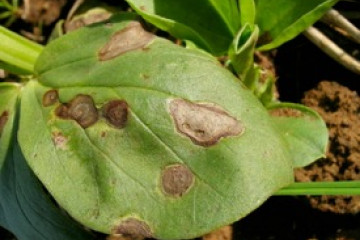
Cercospora (SARDI)
-
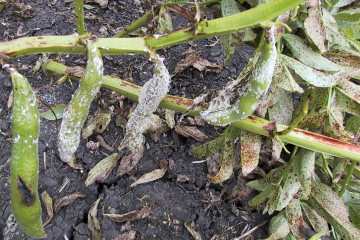
Mouldy pods caused by chocolate spot
-
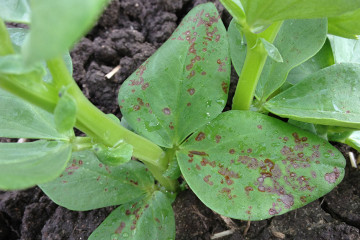
Early indications of chocolate spot
-
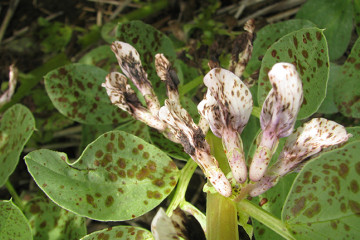
Chocolate spot on faba bean leaves and flowers (J Davidson).
-
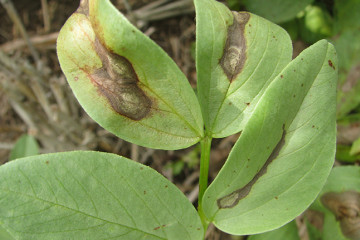
Ascochyta blight on faba bean leaves (J Davidson).
Fungicides registered for use for faba bean in 2022
Many Minor Use Permits have short term expiry dates (e.g. 30/11/2022)
| Faba Bean Foliar Fungicide
|
Trade Name example
|
Chocolate Spot
|
Rust
|
Ascochyta
|
Cercospora
|
WHP Harvest
|
|---|---|---|---|---|---|---|
| Chlorothalonil 720 (Group M5)
|
CC Barrack 720
|
1.4 to 2.3 L/ha
|
1.4 to 2.3 L/ha
|
NR
|
NR
|
7 days
|
| Mancozeb 750 (Group M3)
|
Dithane DF
|
NR | 1.7 to 2.2 kg/ha
|
1.7 to 2.2 kg/ha
|
1.7 to 2.2 kg/ha
|
7 days
|
| Carbendazim (Group 1)
|
Spin Flo
|
500 mL/ha
|
NR
|
NR
|
NR
|
28 days
|
| Procymidone 500 (Group 2)
|
Sumislex 500
|
500 mL/ha
|
NR
|
NR
|
NR
|
9 days
|
| Fludioxonil (Group 12) 150 + Pydiflumetofen (Group 7) 100
|
Miravis® Star
|
750–1000 mL/ha
|
NR | 250–500 mL/ha
|
750–1000 mL/ha
|
NA – do not apply after first pods
|
| Copper (M2)
|
Champ 500DF
|
1.2 kg/ha
|
1.2 kg/ha
|
NR
|
NR
|
1 day
|
| Metiram 700 (M3)
|
Polyram DF
|
1.0 to 2.2 kg/ha
|
1.0 to 2.2 kg/ha
|
1.0 to 2.2 kg/ha
|
1.0 to 2.2 kg/ha
|
42 days
|
| Tebuconazole (Group 3)
|
Folicur SC
|
NR | 145 mL/ha
|
NR | 145 mL/ha
|
21 days |
| Prothioconazole (Group 3) + Bixafen (Group 7)
|
Aviator XPro
|
600 mL/ha
|
600 mL/ha
|
400 to 600 mL/ha
|
400 to 600 mL/ha
|
35 days
(Do not apply after early flowering) |
| Azoxystrobolin (Group 11) + Tebuconazole (Group 3)
|
Veritas
|
1.0 L/ha
|
NR | 1.0 L/ha
|
NR | 28 days
|
| Azoxystrobin (Group 11) + Cyproconazole (Group 3)
|
Amistar®Xtra
|
400–800 mL/ha
|
400–800 mL/ha
|
400–800 mL/ha
|
400–800 mL/ha
|
56 days
|
NR = Not Registered (not effective for this disease)
Read the LabelAs with any chemical application, care should be taken to observe all the label conditions for each product. Some label advice is different for each state or region, so for best results, it is important that this is followed. Many of our pulse crops are exported for human consumption, so market access is dependent on having the product free of chemical residues. Australian has a reputation for providing clean and safe produce so it is vital that this is maintained by using chemicals according to regulations. All permits have label recommendations for use rate and withholding periods (WHP) that must be observed so grain will comply with Maximum Residue Limits (MRL) allowable for market access. |
Key contacts
Pulse Australia Industry Development Managers
- Paul McIntosh
Phone: 0429 566 198 - Phil Bowden
Phone: 0427 201 946
Support and funding acknowledgement
Disclaimer
Information provided in this guide was correct at the time of the date shown below. No responsibility is accepted by Pulse Australia for any commercial outcomes from the use of information contained in this guide.
The information herein has been obtained from sources considered reliable but its accuracy and completeness cannot be guaranteed. No liability or responsibility is accepted for any errors or for any negligence, omissions in the contents, default or lack of care for any loss or damage whatsoever that may arise from actions based on any material contained in this publication.
Readers who act on this information do so at their own risk.
Copyright © 2015 Pulse Australia
All rights reserved. The information provided in the publication may not be reproduced in part or in full, in any form whatsoever, without the prior written consent of Pulse Australia. www.pulseaus.com.au
Last updated: 26 July 2022

